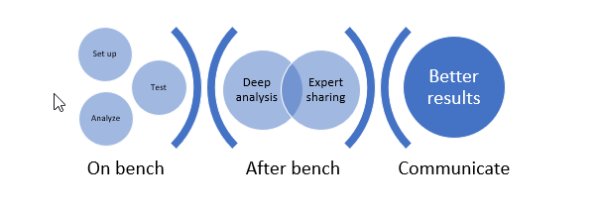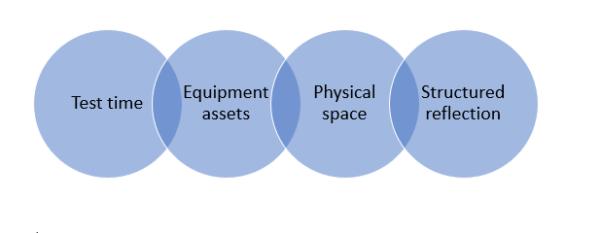The Test Bench Paradox
A paradox is two true statements that conflict with each other. You might not expect to find a paradox in your R & D lab, but one does stand out.
Test bench truth No. 1: limitations and constraints
The complexity of test and analysis drives test equipment technology to its limits. Meanwhile, the equipment needed is increasingly expensive and offers only enough room to accommodate a few engineers at a time at the bench.
Test bench truth No. 2: expanding needs
The quantity, variety, and technology levels of devices requiring test are expanding. Meanwhile, design team size and geographic diversity are growing, and test information needs to flow across organizational and company borders.

The test bench paradox hinders efficient and effective bench test. But advanced remote collaboration software offers a solution to this paradox by enabling a fundamentally reimagined and improved test bench workflow.
- Reimagine bench limitations and constraints by capturing rich data and saving it to your computer for offline analysis. You can manipulate data without physically using the equipment.
- Reimagine expanding bench needs by sharing rich data with your worldwide team of experts. They can continue to independently find insights, do in-depth analysis, and communicate the insights.
Geographically diverse design teams, increasing technical complexity, and limited equipment assets demand dramatically higher bench test efficiency and effectiveness. Only a completely reimagined test workflow can deliver this.

Test Workflow Reimagined
Out with the old
Traditional test workflow looks like this: engineers plan the test, set up the bench equipment, attach the device under test, and perform the test. Then the engineer analyzes the static data. But a test engineer toiling alone at a bench is a relic of a siloed past. Software that leverages a deep level of accessible memory behind each test reading can improve traditional workflow. The software stores information beyond what the engineer saw or analyzed for later use.
In with the new
Imagine a new workflow: The engineer still plans the test — perhaps a bit more carefully — sets up the bench, attaches the device under test, takes the readings, then turns the bench over to the next user. But that is just the beginning.
Better results
By using deep, data-enriched snapshots from the bench after the physical test setup is gone, engineers can do additional signal manipulation and data gathering from those same measurements. They can confer with other subject-matter experts and get input from those experts as to what they might have missed. The whole workflow changes from “on bench” intensive, where the highest value and most in-demand assets are, to “after bench” analysis that is thoughtful, concise, and augmented by expert experience.

Workflow Example: Measure Once, Then Analyze Offline
Let’s step through a use case example — electronic emissions pre-compliance test for a Wi-Fi 6 router — to see how this new workflow is effective. An engineer takes one measurement per compliance line item on a test bench in California, then sends that data across the globe for analysis with different protocols and compliance software. Because the router is set for deployment in the United States, an electronic emissions test for US standards can use the US standards compliance application.
Those measurements can then go to the EU for analysis against its Wi-Fi 6 compliance requirements. The same set of measurements can later move to Asia for comparison with its requirements. Months later, if the compliance specifications change in any of these locations, an engineer can use those same readings to check against new standards in the future.
Group input from subject-matter experts is key to achieving the best analysis. Continuing our electronic emissions Wi-Fi 6 router example, what happens if something goes wrong in one of the pre-compliance tests when exercised against standards in Asia, but the problem hadn’t shown up in the US or EU tests? Test engineers across the globe can see one consistent view of the signal of interest, share it, and execute other views to analyze the problem based on their diverse subject-matter experience.
In a worst-case scenario, engineers cannot resolve the pre-compliance problem identified in Asia using the prior reading. Back at the bench re-creating the prior setup, test engineers in California can solicit troubleshooting suggestions and take new readings to send to the whole team. A new vocabulary emerges in this reimagined test workflow from a geographically diverse design team gathered in an online meeting: “Capture that and send it to me.”
Major Test Bench Bottlenecks Removed
Limited time
Test engineers get limited time on the test bench. They must work to meet tight, demanding schedules. Even if the bench is available and units for test are plentiful, the time that a test engineer can spend on any one test or analysis is often short. This limits how many insightful signal views, expert inputs, and software tools the engineer can exercise with each reading on a test bench. Test engineers cannot think of all the possibilities during a test because they feel the pressure of others who need that device under test or bench equipment.
Limited assets
Demo or prototype units often have limited availability, especially near the end of the development cycle. Engineers, marketing professionals, field sales professionals, and media outlets clamor for a relatively small number of available units. When an engineer who tests a design uses a demo unit for less time, yet performs detailed analyses, what-ifs, and other application-driven tests afterward on a PC, the demo units can be allocated to other stakeholders more efficiently.
Limited bench space
Test benches are tight. It would be nice to be able to put 10 experts at the bench who comment and take readings. But there’s simply no room. Further, test benches limit the amount of equipment, cabling, and probes that can be used effectively without injecting noise and crosstalk errors into the test.
Limited reflection
Taking the opportunity to explore what-ifs and confer with experts is important. If you have ever missed something critical after taking measurements, then you likely wish that you could do just one more view, take one more analysis step, or apply one more built-in software application on that reading. The solution is the new workflow enabled by extended offline capability. Measure once, then analyze afterward offline.

Solved: The Test Bench Paradox
The solution to the paradox of bench limitations versus expanding needs requires simultaneously reimagined test workflows, powerful collaboration software tools, and an intuitive user interface.
- Reimagined test workflows: Test changes from bench-intensive, where the highest value and most in-demand assets are, to on-bench data-gathering followed by after-bench analysis.
- Powerful collaboration software tools: Advanced remote collaboration software leverages your bench equipment’s powerful processor and deep memory to achieve better results than real-time testing.
- Intuitive user interface: Your personal computer becomes the bench equipment that you already know how to use. It has the same layout and controls, and it offers access to the same applications — zero training required.
- Remote Collaboration Solves the Test Bench Paradox - June 17, 2020



